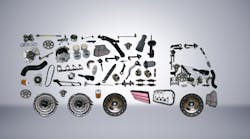Fullbay, which provides a heavy-duty repair shop management platform to commercial vehicle shops, recently launched a new tool called Fullbay Marketplace to assist customers in finding and ordering parts. The comprehensive portal provides visibility into cost, available inventory, and expected shipping times. The main benefits—accessible to all Fullbay customers—include slashing the order process from up to 10 steps down to three, as well as providing more visibility into real-time inventory of a specific part.
FinditParts is the inaugural vendor, with other sources joining the system in the near future.
During a recent webinar, Fullbay’s CEO and founder Jacob Findlay, COO Chris O’Brien, along with FinditParts CEO David Seewack, discussed how the site works, and more importantly, why tools like this are needed now more than ever.
And right now, the transportation industry could use all the help it can get resolving current challenges in obtaining parts. The COVID-19 pandemic and subsequent plant stand-downs started the supply chain disruptions in 2020, with unprecedented port congestion exacerbating wait times. And it’s not clear when consistency will return.
“If you haven't felt it yet, there's a good chance that you still will feel it, because it's not ending anytime soon,” asserted Findlay, citing a Wall Street Journal article that predicted supply chain issues throughout 2022. A few days after the webinar, the 132-year-old newspaper ran a story arguing that interruptions won’t cease until the end of 2023.
Difficulty finding parts for repairs, paired with a general shortage of labor, has impacted shops’ ability to keep customers happy and generate revenue, O’Brien said. “Some shops actually are folding up just for not being able to find resources,” he explained. “They don't have the relationships with 14 suppliers—they have two or three in their backyard, can't get the parts, and they're losing business.”
Findlay pointed out that this is also affecting overall fleet uptime and causing some non-critical repairs to be skipped.
“It's that much harder to get small things fixed," Findlay said. “So at scale, we're talking about trucks that maybe aren't as well maintained as they otherwise could be as parts are more available.”
This in turn could cause safety issues. According to the Commercial Vehicle Safety Alliance's (CVSA) 2021 International Roadcheck, brake systems topped the list of out-of-service violations, accounting for 26.5% of OOS vehicle violations.
“If you only fix what's broken, that's a recipe for having long term issues,” O’Brien said. “So, it's all about preventive maintenance.”
That’s a major problem for carriers, which are needed to alleviate logistical challenges, but themselves can’t easily find the parts to keep their trucks running.
“Everywhere through the [supply] chain, we're seeing problems for the parts shortage,” noted Seewack, who lamented how much more difficult running a fleet has become due to shortages. “The parts shortage was never in the equation; they always knew parts were available, they just needed to get it repaired and back on the road.”
FinditParts has more than 10 million OEM and aftermarket parts in its database, worth $6 billion in total, Seewack said. Even with that volume of inventory, fleets are still having trouble getting what they need.
Seewack, who has 25 years of experience in the heavy-duty truck parts sector, recounted a few anecdotes on how fleets and dealerships are trying to sort things out.
The online vendor typically might have 10 to 20 suppliers for a particular part, Seewack explained, but recently in the case of a suspension part from an OE that had 14 suppliers, only one of them had it for a customer. “That certainly demonstrates a reasonably popular part that most people are out of,” Seewack said.
Seewack said OEMs and the aftermarket are also seeing similar challenges, exemplified by FinditParts selling an OEM dealer a part recently that it should have been able to procure on its own. Seewack said that dealer may not have checked the necessary distribution centers or other local branches before going to FinditParts.
The FinditParts CEO also noted that a previous fleet strategy was to take parts off of an unutilized asset in a pinch, but now “they're using every one of them, so they don't have the chance to do that any longer.”
Read more about how fleets are pulling equipment and cannibalizing parts.
While Fullbay Marketplace is currently in beta testing with FinditParts, Findlay said once fully launched, the solution will be able to mitigate situations like this.
“The part you're looking for, that [leading parts supplier] FleetPride may not even have in stock, might be sitting on the shelf of a random shop across the city from you and they don’t need it,” Findlay explained after the webinar to FleetOwner. “So, how can you get visibility to that, and get that part, and get the truck back on the road? So, that's something we're definitely exploring.”
He said ecommerce innovations such as the one developed by Fullbay, along with suppliers working together, will be the key to providing fleets relief.
Help could be found by expanding your vendor list, he said. This includes commercial shops, non-local vendors, and even salvage yards.
“I don't think any one company can solve all of this,” he said. “It has to be solved via collaboration and cooperation.”
O'Brien said that he has seen this collaboration happening, such as with some Ohio shops.
"Shops that are competitors are coming together, because they both stock different things that each needs, and it's really great seeing people work together instead of going from a competitive stance."
This article originally appeared in Fleet Maintenance.





